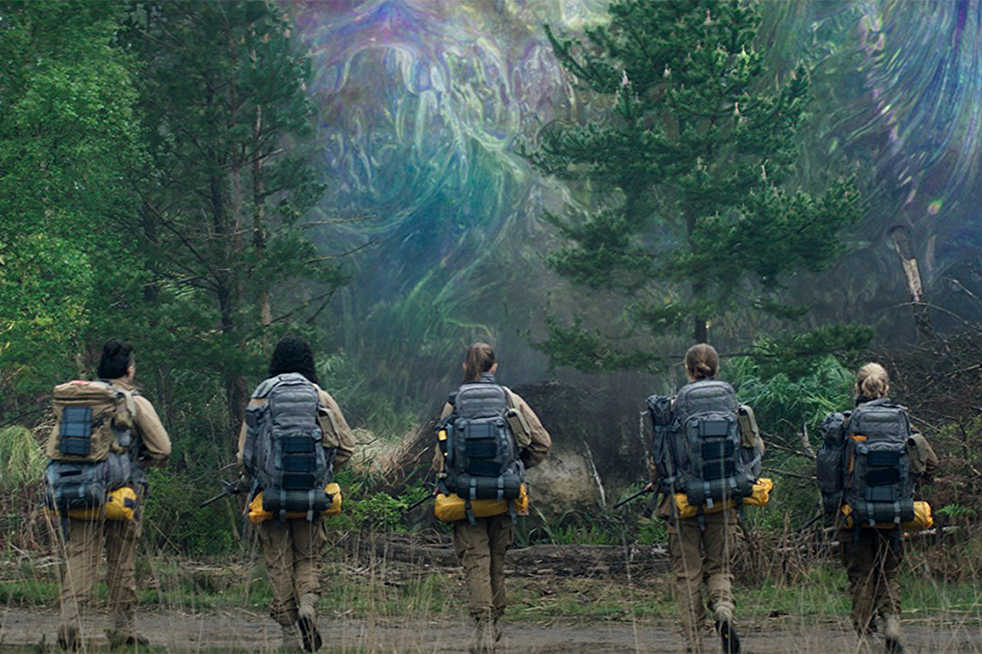Good science fiction can take many forms, but these different forms can often seem at odds with one another. For some, science fiction is meant to be cerebral, conjuring a cryptic, fantastical allegory for modern society. For others, science fiction’s appeal comes from the spectacle of unfathomable worlds and lightshow special effects.
What can easily fall through the cracks is strong character development and emotional engagement of the audience. Characters can easily be flattened into vehicles for the plot or figurative everymen to be twisted by the film’s central allegory. In this respect, “Annihilation,” the newest film by Alex Garland (“Ex Machina”), has a little bit of trouble deciding what it wants to be.
In the near future, an asteroid containing an alien presence crashes into a lighthouse in Florida and from the crash site buds an ever-expanding realm known as “The Shimmer.” The government continually sends soldiers into the mysterious region, but none
ever return.
Three years later, one of the soldiers, Kane (Oscar Isaac, “Inside Llewyn Davis”), inexplicably reappears in an amnesiac state. He returns to the home of his wife, Lena (Natalie Portman, “Black Swan”), a biology professor at Johns Hopkins, before collapsing and being hospitalized by government forces. Bent on discovering what is afflicting her husband, Lena volunteers to join the first dedicated team of scientists entering the Shimmer.
Four other female scientists join her. Each harbors self-destructive tendencies that predispose her to volunteer for the position. As they venture into the Shimmer, they find a beautiful, horrifying perversion of reality. Captured in vibrant, vivid hues, the Shimmer, which outwardly appears to be composed of a rainbow film containing its world, is a stunning yet unnerving reimagining of nature.
As the envoy learns, the Shimmer twists, refracts, melds and splices together whatever is within it borders, from light and radio waves to the very minds of the scientists. They face fantastical amalgams of life on Earth, from gargantuan crocodiles with shark teeth to plants that grow woven in the image of people.
Yet, this is still a hostile world. The film follows these explorers, seeking to find the source of the Shimmer, as they face the realm’s terrors and their own mounting paranoia at the prospect of becoming one of the Shimmer’s mutations.
With the exception of a couple CGI hiccups here and there, Garland’s visuals do a remarkable job capturing the fragile balance between majesty and disquietude within the Shimmer. Likewise, outside the Shimmer, Garland’s claustrophobic framing captures a similar balance in flashbacks to Lena’s home life with Kane.
At least, in the beginning of the movie, when the audience sees Lena, aggrieved after her husband’s disappearance, Garland offers a delicate depth to enrich Lena’s character. Viewers see Kane and Lena’s unmistakable chemistry during their playful pillow talk and feel the equally evident tension when Kane returns to the restrictive hallways of their home one year later, an obviously changed man.
Over time, however, the film pivots a couple times. As soon as Lena and her companions enter the Shimmer, much of the film’s most human elements are lost, relegated to the occasional flashback. Instead, Garland presents a sci-fi action horror punctuated by some truly thrilling and terrifying sequences that leverage the Shimmer’s world to agitate the most stolid of those watching. As effective as these sequences are, much of the second act feels like a reimagining of other sci-fi horrors in films like “Alien” and “Predator.”
Still, Garland makes it clear that the perilous journey will amount to something more. For every monster they encounter, the scientists also come across unfathomable floral arrangements as well as bodies decaying into breathtaking murals of overgrowth.
Each of these sequences is accentuated by Geoff Barrow and Ben Salisbury’s evocative sound choices. Characterized by blaring drones of noise that sound alien and overwhelmingly disquieting, the score assures that Garland still has a card to play.
Many recent science fiction films, like “Arrival,” “Blade Runner 2049” and “Moon,” offer viewers intriguing thought exercises in their first acts, but they fail to follow through on their provocative ideas by the time the third act rolls around. Fortunately, “Annihilation” is the opposite.
The final act pushes Lena into a surreal, cerebral encapsulation of the film’s themes. Garland ties the figurative threads of the film together in a finale that astonishes. Its measured ambiguity leaves the viewer with plenty to mull over after the credits roll.
Finally faced with the source of the Shimmer, Lena’s encounter raises some potent questions regarding the cycle of self-destruction and creation that nature imposes on all life. In this bittersweet dance between erasure, change and creation, Garland asks the audience to consider how their own identities have been refracted.
“Annihilation” is not a perfect film. Gaining and losing several narrative and genre strands over the course of its run time, Garland’s film struggles to assure viewers of what it wants to be. Nonetheless, Garland has created an ambitiously original and thought-provoking film that has earned its place in the science fiction canon.
